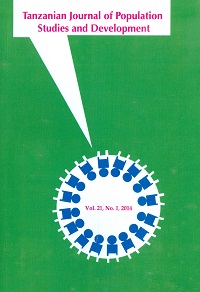Challenges of Monitoring Food and Nutrition Security in Rural Areas Using Longitudinal Methods: Experiences from the Rufiji Sentinel Food Security and Nutrition Monitoring (FSNM) Study, Tanzania
Abstract
This paper gives an empirical account of the challenges of monitoring food and nutrition security in rural areas using panel data, and proposes some corrective measures against most common problems. The presentation uses the case of Rufiji Sentinel Food Security and Nutrition Monitoring (FSNM) study, whose objective is to generate information on food security and nutritional status. An important lesson from the research is that using the iterative survey process that involves taking precautionary measures during planning, as well as periodic modifications of tools and methods for data collection, can generally increase the accuracy of the collected data and the validity of conclusions derived from them. This means that researchers must ensure that sufficient enumerator training, supervision, and quality control mechanisms are in place both before and during data collection. All these have implications for capacity building for planning and implementation of data collection in developing countries.
References
Casley, D.J., & D.A. Lury. 1979. Data Collection in Developing Countries. Oxford: Oxford Press.
Devereux, S., & S. Maxwell. 2003. Food Security in Sub-Saharan Africa. London: ITDG Publishing.
FAO. 2002. Measurement and Assessment of Food Deprivation and Undernutrition: Summary of Proceedings. International Scientific Symposium. Rome, 26-28 June 2002.
Gujarati, D.N. 1995 Basic Econometrics. Fifth Edition. McGraw-Hill Inc. International Edition.
Johnson, A.C. Jr., & J.S. Rowe. 1987. Agricultural Statistics for Developing Countries. Wisconsin: University of Wisconsin-Madison.
Kish, L. 1987. Statistical Design for Research. New York: John Wiley and Sons.
Mwageni, E, H. Masanja, Z. Juma, D. Momburi, Y. Mkilindi, C. Mbuya, H. Kasale, G. Reid, & D. de Savigny. 2005 ' Socioeconomic Status and Health Inequalities in Rural Tanzania: Evidence from the Rufiji Demographic Surveillance System. In: INDEPTH-Network, (ed). INDEPTH Monograph Series. Demographic Surveillance System for Assessing Populations and their Health in Developing Countries. Accra: INDEPTH.
Narayan, D., & L. Srivastava. 1994. Participatory Development Tool Kit: Training Materials for Agencies and Communities. Washington, D. C.: World Bank.
Ravallion, M. 1996. How Well can Method Substitute for Data? Five Experiments in Poverty Analysis. The World Bank Research Observer, 11(2): 199-221.
Rowe, J.S., & J. DeCosse. 1992. Survey Planning, Non-sampling Errors and the Dairy Marketing Researcher. In: R.F. Brokken, S. Seyoum (eds). Dairy Marketing in Sub-Saharan Africa. Proceeding of a Symposium held at ILCA, Addis Ababa, Ethiopia, 26-30 November 1990. ILCA. (International Livestock Centre for Africa), Addis Ababa, Ethiopia.
Schaeffer, R.L., W. Mendenhall, & L. Ott. 1986. Elementary Survey Sampling. Boston: Duxbury Press.
Yates, F. 1981. Sampling Methods for Censuses and Surveys. Fourth edition. London: Charles Griffin and Company Ltd.


